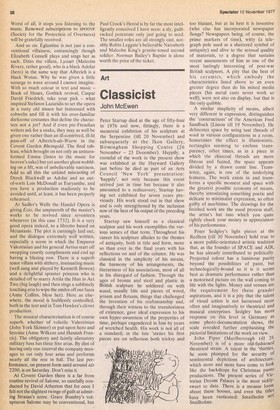Art
Classicist
John McEwen
Peter Startup died at the age of fifty-four in 1976 and now, fittingly, there is a memorial exhibition of his sculpture at the Serpentine (till 20 November) and subsequently at the Ikon Gallery, Birmingham Shopping Centre (26 November — 23 December). Happily, a roomful of the work in the present show was exhibited at the Hayward Gallery just before he died as part of an Arts Council 'New York' presentation: 'happily', not only because this event arrived just in time but because it also amounted to a rediscovery, Startup having not exhibited for seven years previously. His work stood out in that show and is only strengthened by the inclusion now of the best of his output of the preceding years.
Startup saw himself as a classical sculptor and his work exemplifies the various senses of that term. Throughout his career his sculpture alludes to the themes of antiquity, both in title and form, more so than ever in the final years with his reflections on and of the column. He was classical in the simplicity of his means, the harmony of his arrangements, the literariness of his associations, most of all in his disregard of fashion. Through the ages of bronze and steel and plastic in British sculpture he soldiered on with wood, usually bits and pieces of wood, jetsam and flotsam, things that challenged the invention of his craftsmanship and, through their witness to the transitoriness of existence, gave ideal expression to his own hyper-awareness of the properties of time, perhaps engendered in him by years of wretched health. His work is not all of a standard; in the late 'sixties his first pieces are on reflection both tricksy and too blatant, but at its best it is inventive (who else has incorporated newspaper flongs? Newspapers being, of course, the prime markers of time), witty (a telegraph pole used as a shattered symbol of antiquity) and alive to the sensual quality of materials, to a degree that sustains recent assessments of him as one of the most lastingly interesting of post-war British sculptors. A pity that the best of his ceramics, which embody the characteristics listed above to an even greater degree than do his mixed media pieces (his metal casts never work so well), were not also on display, but that is the only quibble.
A similar simplicity of means, albeit very different in expression, distinguishes the 'constructions' of the American Fred Sandback (Lisson till 19 November). He delineates space by using taut threads of wool in various configurations in a room. Sometimes the effect is illusionistic, rectangles seeming to enclose transparency, other times, as in a piece in which the cliarcoal threads are more fibrous and fuzzed, the space appears divided by a drawn conee line. Transience, again, is one of the underlying features. The work exists in and transforms a specific moment and space with the greatest possible economy of means, thereby introducing something poetic and delicate to minimalist expression, so often guilty of machismo. The drawings for the finished work are the usual process stuff, the artist's hat into which you quite rightly chuck your money in appreciation of his performance.
Peter Sedgley's light pieces at the Redfern (till 30 November) hold true to a more public-orientated artistic tradition that, as the founder of SPACE and AIR, he has already contributed to politically. Projected colour has a luminous purity beyond the possibilities of paint, but technologically-bound as it is it seems best as dramatic performance rather than a motorised picture on the wall coming to life with the lights. Money and venues are the requirement for these grander aspirations, and it is a pity that the talent of visual artists is not harnessed more often and imaginatively to theatrical and musical enterprises. Sedgley has more response on this level in Germany as some photo-documentation shows, the scale revealed further emphasising the pictorial limitations of the work on view. John Piper (Marlborough till 26 November) is of a more old-fashioned theatrical strain. A talent in the 'thirties, he soon plumped for the security of sentimental depictions of architecture, which more and more have come to look like the backdrops for Christmas panto productions. The present series of Victorian Dream Palaces is the most sicklY' sweet to date. There is a mousse loose aboot these hooses, and even the titles nave been rusticated: Smailholm flot Snailholme.


































 Previous page
Previous page